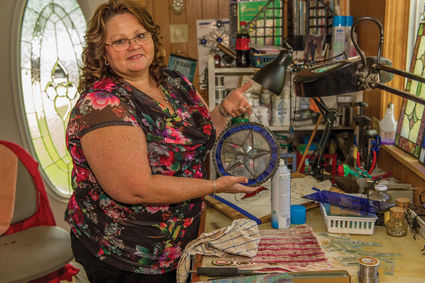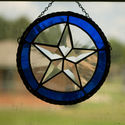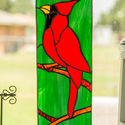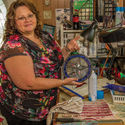Stained glass: Art that glistens
Last updated 9/4/2013 at Noon
Gwen Tallant loved stained glass but couldn’t afford the costly beautiful piece of art, so she decided to take classes to learn how to make it herself.
That was 13 years ago. Now her colorful hobby has her shop full of the glass. She also teaches classes for those who want to learn to make stained glass art too.
But, she is not the first person to admire the beauty of stained glass. Based on remains found at Pompeii and Herculaneum, stained glass was first used by wealthy Romans in their villas and palaces in the first century A.D. At this time stained glass was considered a domestic luxury rather than an artistic medium. It began to be regarded as an art form when Constantine first permitted Christians to worship openly in 313 A.D., as they began to build churches based on Byzantine models. The earliest surviving example of pictorial stained glass is a Head of Christ from the tenth century excavated from Lorsch Abbey in Germany, according to History of Stained Glass.
Stained glass, as an art and a craft, requires the artistic skill to conceive an appropriate and workable design, and the engineering skills to assemble the pieces. The term stained glass can refer to colored glass as a material or to works created from it.
Tallent has completed many pieces over the years. Some of which include, a Texas star, flowers, crosses, birds, and almost anything else. She often uses patterns or pre-cut beveled glass, but she knows if she can’t find what she is looking for, she can send off a drawing and a pattern will be returned back to her. However, she has been known to “free-hand” a pattern herself. She once saw an inspirational sunset during an outing. When she returned home, she drew it out. Once it was assembled, the one of a kind piece was sold for someone else to enjoy.
Scattered throughout her workshop are the many colors of glass. Some are future projects and others are remnants from past snippets of her work.
“I never knew there were so many shades,” Tallant said.
But, there are also different textures of each color. Some of the textures are rolled, granite or hammered. Each texture gives the color a depth and a place for the sun to shine through.
Also scattered on the shelves or on her desk are boxes of band-aids. She admits over the years, she had cut herself more than a few times.
‘Glass is not forgiving,” she said. “It will cut you or it will break.”
Tallant drives to Houston for her glass but it is well worth the drive to come back with her new treasures. Sometimes, the right color of glass can make the project extra special. Such as the deep red glass used as a flame beside a cross which is the most popular item sold for Tallant.
The red glass is more expensive because metallic gold, in very small concentrations is used to produce a rich ruby-colored glass. In lower concentrations it produces a less intense red, often marketed as “cranberry glass.” The color is caused by the size and dispersion of gold particles.
Depending on the “look” wanted to achieve, glass can vary in price from $5 to $35 per square foot, according to Tallant.
She begins each project with a pattern of card stock. She uses three pieces of paper for the project. One will be used to place onto the wooden board while the other will be kept in a file for future use. Using a pattern, she draws the shapes onto the glass. With a glass cutter she runs over the lines she previously drew. With a gentle snap, she pulls the pieces apart.
Once the pieces are apart, she takes them to the grinder to get rid of the sharp edges. The pieces are cleaned and placed back onto the board. Like a jigsaw puzzle, she assembles the pieces to form the picture.

Gwen Tallant works on adding patina to a finished stained glass piece of a Texas star. A Texas star hangs in the window of the work space for Gwen Tallant. She not only makes them in brilliant blue, but also ruby red. A cardinal is one of the stained glass pieces made by Gwen Tallant. RECORD PHOTOS: Larry Trimm.
The next step is to put copper foil to flux over everything before soldering the pieces together. Once the pieces are soldered together, she can put the frame around it. Sometimes it is a wooden frame and lead for the smaller pieces or zinc. She rubs on patina, a chemical which will age the metal. The final step is a wax coating which helps to keep it sealed.
Tallant takes up to three hours to complete the smaller pieces. However, she has been known to work on some of the larger and more detailed pieces several days.
“When I finish a piece, it’s the satisfaction of having something done,” she says of her work.
Christmas is a few months away, but to give her art the time and dedication needed, she is taking orders now. She has books of patterns for people to choose from or they can present a favorite picture.
For more information on taking classes or placing an order, contact Tallant at 409-313-2887.
Gwen Tallant works on adding patina to a finished stained glass piece of a Texas star. RECORD PHOTOS: Larry Trimm.


















Reader Comments(0)